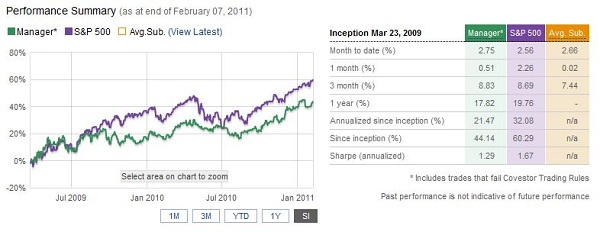Author: Michael Arold
Covestor model: Technical Swing
Disclosure: Short MIPS, MCD; Long TWM

Market trends usually do not end all of a sudden. Signs of weakness tend to creep in before major market declines and prompt traders to either take profits more often or to open short positions. I used both of these strategies in January.
I wrote in my last report that various sentiment measures started to show warning signs. For example, I follow the number of S&P 500 stocks above or below their 50-day moving average. In January, we saw a trend that started in 2010 intensify: the index was recording new highs, while more and more stocks traded below their moving averages. Obviously, the rally was losing steam and major indices were taken higher by fewer stocks.
In the last weeks, other factors indicated weakness under the hood: small cap and emerging market stocks, usually an indicator of investor’s risk appetite, underperformed. Leading “momentum stocks” such as F5 Networks (FFIV) or MIPS Technologies (MIPS) – a stock I shorted on January 28 – broke down after disappointing earnings reports. Another warning sign: according to Bespoke Investment Group on January 26 (http://www.bespokeinvest.com/thinkbig/2011/1/26/bullish-sentiment-above-50-for-eleventh-straight-week.html), bullish sentiment as defined by the Investors Intelligence weekly survey of advisors had remained above 50% for eleven straight weeks. High readings on this survey often signal weakness ahead, based on the contrarian position that too much optimism indicates that everybody is already invested and no money is left to buy stocks and push the markets higher.
Let’s make this clear: I’m not predicting a bear market, but rather a healthy correction, which could possibly lead the markets down by 10 percent or so. Declines of this size are usually not a concern for the long-term buy and hold investor. However, as a short-term trader, there is enough room to benefit from such weakness through short positions.
As of January 31, I am shorting small-cap stocks by holding the inverse leveraged ETF TWM to benefit from weakness in the Russell 2000 index.
Another theme I’m trying to exploit is rising input costs and margin compression. Commodity prices have been on the rise for the last few months. It was very interesting to see various companies reporting weak earnings in January as a result of higher costs. For example, Reuters reported that McDonald’s (MCD), a stock which I shorted on January 28, announced in its quarterly earnings report that it “would charge more for some menus to help offset expected rises in the 10 commodities that make up around 75 percent of the cost of preparing its food” (“Companies pull hard in pricing tug-of-war,” Reuters, 1/28/11, https://www.reuters.com/article/2011/01/28/pricing-idUSLDE70B0OG20110128).
In another industry, Ford presented disappointing earnings on January 28, which “also reflected higher commodity costs” (Reuters, 1/28/11, “Higher costs sink Ford profit, shares slide” http://mobile.reuters.com/article/topNews/idUSTRE70R2GW20110128?ca=rdt).
So if companies are obviously reporting the first signs of inflation, what is the situation with gold? In 2010, I traded gold from the long side. Since the beginning of this year, my stance has changed and one of my trades in January was to short the yellow metal. I closed the position, but have gold on my watchlist for further shorting. My rationale is simple: Gold is more sensitive to real interest rates than to inflation, a thought the general public seems not to grasp. I expect real interest rates to rise, so gold has to compete with soft assets, especially bonds, which offer better returns.
In addition, the long-gold trade is extremely crowded, which creates opportunities on the short side. Similar to stocks, I’m not expecting the bull market in gold to end, since it looks like quantitative easing will continue. However, a major correction could be in the cards this year.



